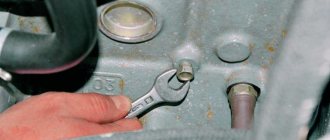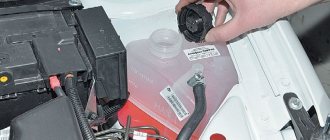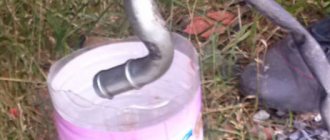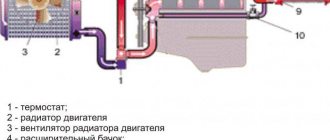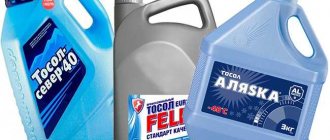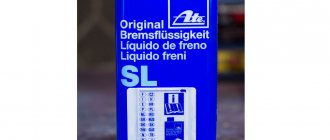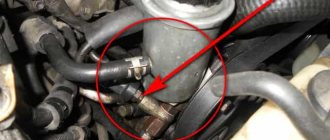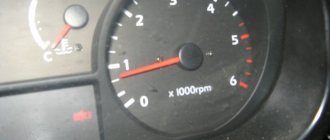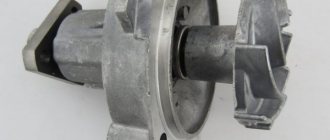How to replace coolant on a VAZ 2101-VAZ 2107?
Draining:
1) First, drive the car into the pit.
Note!
The car must be level, or the front must be higher than the rear, but not vice versa!
3) Next, move all the way to the right, the lever that opens the supply of warm air into the car interior; in the VAZ 2106, such a lever is located on top and in the photo it is indicated by the letter “A”.
5) Then unscrew the radiator filler cap, which is also indicated by an arrow in the photo below.
6) Now remove the drain plug located on the cylinder block.
Note!
After you unscrew the drain plug located on the cylinder block, immediately place a bottle under this hole and drain all the used fluid into it!
7) Then unscrew the radiator drain plug and drain all the waste fluid from the radiator into a bottle.
 Next, unfasten the belt that secures the expansion tank, and then lift the tank up, as a result of which the remaining coolant will drain out of it and from the hose that is connected to it, which will flow through the radiator drain hole.
Next, unfasten the belt that secures the expansion tank, and then lift the tank up, as a result of which the remaining coolant will drain out of it and from the hose that is connected to it, which will flow through the radiator drain hole.
Pouring:
1) First, install the radiator tank in place, and also tighten the cylinder block drain plug and the radiator drain plug.
2) Then pour new coolant into the radiator.
3) Next, pour new fluid into the radiator expansion tank.
Note!
Pour new coolant into the expansion tank, just 3-4 cm above the MIN mark!
5) Now screw the radiator cap and expansion tank cap into place.
6) Then start the car and let it idle for about 4-5 minutes, after 4-5 minutes of operation, turn off the car and add coolant to the expansion tank and radiator to the required level.
Important!
- Replace the coolant only when the engine is cold!
- The liquid is very toxic, so you should only replace it outside or in a well-ventilated area!
- After about three days have passed after the replacement, check the fluid level and, if possible, bring it to the required level!
Additional video:
Don't understand where the expansion tank is located? And you also don’t understand where the drain plug is located on the cylinder block? Watch the video below for answers to all these questions:
You will learn how to drain antifreeze from a VAZ-2107 from this article. This manual can be used for any Lada model, regardless of the year of manufacture and drive. But you will have to consider such issues as the service life of antifreeze, how it differs from antifreeze, and during what work it may be necessary to drain the liquid. Both the “kopek” and the “ten” have two drain holes. But the cooling system designs of these cars are different. For example, on the “classic” the liquid is not under pressure, while on the “eight” and newer models it is about 1 atm.
Pouring liquid into the system
What kind of coolant to pour into a VAZ 2114 is always a concern for car owners of these cars. There is no big difference, you can pour antifreeze into the cooling system, you can also add antifreeze, but mixing the compounds is still very undesirable. Antifreeze has a more aggressive environment due to other additives, and its too concentrated composition can even “corrode” the radiator over time. Top up with the brand of coolant that was previously filled in the system. If the brand is not known, then it is better to completely replace the fluid.
Replacement with flushing
Is it possible to replace antifreeze with antifreeze? Why not. It is only necessary to flush the cooling system when replacing antifreeze with antifreeze. Conversely, you need to flush the cooling system when replacing antifreeze with antifreeze. already indicated - the compositions are different and mixing can lead to foaming of the coolant. Of course, an explosion will not occur, but long-term use of the mixed composition is not recommended. The system should be flushed with clean water, and the water should be changed several times. Rinse until clear liquid, free of dirty impurities, drains from the radiator.
Replacing the coolant on a VAZ is done with your own hands in stages:
- We park the car level; at an angle, all the coolant may not drain out;
- expansion tank;
- Unscrew the drain plug at the bottom of the radiator. We prepare the container into which the contents from the radiator are drained in advance;
- We twist the plug on the cylinder block and drain the coolant from the block. To get to the plug, you need to remove the ignition module. The module is secured with three bolts;
- We tighten the plugs, fill in water and start the engine. Let the engine run for fifteen minutes;
- As already written above, we flush the system several times;
- Then fill in new fluid and remove the airlock. How many liters of antifreeze are provided in the VAZ 2114, so many should enter the system.
Removing the air lock
How to add antifreeze if there is an air lock? There are different ways to fill liquid (discussed below).
Removing air through the throttle assembly:
- Remove one of the coolant supply hoses to the throttle valve.
- Remove the expansion plug with a clean rag.
- Blow through a rag into the reservoir until coolant flows from the removed hose.
- Quickly put the hose in place, tighten it with a clamp, and add fluid to the level. How much antifreeze will still fit into the VAZ 2114 depends on how “airy” the system is.
Removing air through the throttle without removing the expansion tank plug:
- We heat up the engine and turn it off.
- Remove one of the throttle hoses.
- After a short time, the air should come out and antifreeze should flow.
- We also quickly put on the hose.
- Check the coolant level and add it as necessary.
Bleeding air by placing the vehicle at an angle:
- We're heading uphill.
- Remove the tank cap.
- Warm up the engine to operating temperature.
- We accelerate sharply. If liquid falls into the system, add it.
You can change the cooling radiator on a VAZ yourself. In this case, an air lock may also form. You need to control how many liters of antifreeze will fit into the VAZ 2114. If there is a lot of new coolant left in the canister, it is necessary to remove the plug, otherwise the engine may overheat.
It should be remembered that the volume of the cooling system in the VAZ 2114 is approximately 7.5-8 liters.
If you don’t want to bother with replacing the coolant, you can take the car to a car service center. The cost of such work depends on the region and the level of equipment of the car workshop or center. On average, the price ranges from 300 to 600 rubles.
- Hot liquid must be drained carefully, using gloves and thick, waterproof clothing.
- After replacement, you need to check if there is an air lock in the system. The air must be expelled, otherwise the engine may overheat .
- When draining the liquid, use a plastic bag or rag to prevent coolant from getting into it.
- When mixing antifreeze with antifreeze, nothing particularly bad will happen, but it is still advisable to avoid mixing.
Take care of your car!
A car uses many mechanisms and systems. One of these is cooling. During operation, the engine generates a huge amount of heat. Without a cooling system, it would overheat in a matter of minutes. This system was designed precisely to maintain the optimal temperature range. Few people think about it, but it needs to be serviced periodically. One of these operations is replacing the coolant. What is it and how much antifreeze should I pour into the VAZ-2110? See the answer in our article today.
Why is it necessary to change antifreeze?
In any modern car, antifreeze circulates in a circle, taking heat from the engine jacket. It is worth noting that there is no need to unscrew the cap of the expansion tank before draining the antifreeze from the VAZ-2107. Injector or carburetor - it doesn’t matter, the circuit is identical. The first "sevens" used water as a liquid. But it has a lot of disadvantages - it freezes at sub-zero temperatures outside, forms scale on the walls and in the pipes, and damages the pump.
Antifreeze is devoid of all these shortcomings, but still has several nuances. The service life is limited - no more than two years, or 90-100 thousand kilometers. Antifreeze is a complex compound that contains a large number of additives. And due to temperature changes, these additives evaporate and lose their properties. The result is that the boiling point increases, the viscosity decreases, and there is a risk of pump breakdowns.
Filling volumes and brands of oils and liquids LADA (VAZ-2107 Zhiguli)
Filling/lubrication point
Name of oil/liquid
How much and what to fill in VAZ 2107
Fuel tank volume – 39 l. The manufacturer recommended using gasoline with an octane rating of 92 or 95.
The quality of operation of components and assemblies depends on the regularity of replacing lubricants. Engine oil lasts no more than 10 thousand km. After which it is necessary to change it to a new one. Lubricant fluid (with API quality level: SG, SH, SJ) is suitable for the VAZ 2107. During the procedure, a new oil filter must be installed. The same oil is used for the engine crankcase as for the power plant.
The service life of antifreeze is 60 thousand km. Even if the car is not used, the fluid loses its properties after two years, so it needs to be replaced.
The transmission oil is changed every 60 thousand km. At the same time, its level is periodically monitored. After 20 thousand km it may decrease, which will negatively affect the operation of the unit. The defect must be eliminated and oil must be added to the edge of the filler hole. This also applies to the rear axle housing. The gearbox filling volume is 1.6 liters.
Antifreeze or antifreeze?
Now you’ll figure out how to drain antifreeze from a VAZ-2107. But what to pour into the cooling system if there are two types of liquids on the market - antifreeze (blue) and green). But in fact, you just need to go into the terminology. In fact, antifreeze is antifreeze (literally “against the cold”). But those liquids that are called antifreeze are produced using domestic technology, and “antifreeze” is produced using imported ones. In fact, any alcohol can be called antifreeze, since it does not freeze at earthly temperatures. But one feature cannot fail to be noted - imported analogues of coolant are of much better quality and have a longer service life. Therefore, it is preferable to use liquids under the trade name “antifreeze”, despite the fact that it is 100-200 rubles more expensive than antifreeze (10 liter canister).
Cooling system VAZ 2114
Once upon a time, back in Soviet times, water was poured into a car radiator as coolant. But it was very inconvenient - in cold weather it was necessary to avoid defrosting the system, and in the morning before the trip I had to run around with buckets of hot water. In addition, the cooling jacket in the cylinder block and in the cylinder head suffered from corrosion. Nowadays, water is practically no longer used; antifreeze or antifreeze is poured into the cooling system (CO).
The volume of coolant in CO is about 8 liters (7.8 liters according to factory conditions). , which came off the assembly line, any coolant can be filled in; the manufacturer does not adhere to any specific rules in this matter.
But if the fluid runs out or the time has come to replace it, then topping up or replacing is necessary. And here you need to know what is poured into the system, and whether it is possible to mix antifreeze with antifreeze.
Antifreeze
The name "antifreeze" contains Greek and English roots. The Greek “anti” means “against”, the English “freeze” translates to “freeze”. Therefore, the coolant, the cooling system, must not only prevent overheating of the internal combustion engine, but also not freeze in frosty weather. The basis of antifreeze is ethylene glycol, and the freezing point of the coolant depends on how much water is added to the chemical composition. The fluid components do not cause corrosion of engine parts.
The composition can be of almost any color; ethylene glycol itself is colorless. The composition is painted so that it can be seen in case of leakage, and so that it is not drunk by mistake; the antifreeze itself is poisonous. In addition, the old coolant changes color, which means it is time to replace it.
Antifreeze
Antifreeze is a type of antifreeze, only at one time it was specially developed for VAZ cars. It is blue in color and can be concentrated, diluted 60% with water (grade A-40M), diluted 35% (A-65M). The concentrate is not used in its pure form; it is diluted at your discretion, depending on the freezing temperature that is oriented towards in the region where the car is located. Antifreeze has a more aggressive environment, but this does not mean that it is of low quality.
Myths about antifreeze and antifreeze
- Antifreeze is worse than antifreeze. This is not true. Both coolants are made from the same base (ethylene glycol). But their density is different, and different instruments (ariometers) are used to measure this parameter.
- The color of a liquid is an indicator of quality, and its composition depends on the color. In fact, the composition of the coolant is basically similar for all, and does not depend in any way on the color. Antifreeze is mainly tinted green and red.
Precautions and Rules
Be sure to follow safety requirements, since draining antifreeze from a VAZ-2107 without this will be a risky undertaking. So, the basic requirements:
- Do not drain liquid in the yard or garage. Antifreeze is toxic; fumes entering the lungs can cause irritation of the mucous membranes and poisoning.
- You can’t “taste” it - it’s completely deadly. Some “experts” try the liquid to make sure that it is really antifreeze. Such an experiment is very dangerous.
- If the liquid comes into contact with your eyes or hands, rinse them thoroughly with water. If you suspect poisoning, consult a doctor.
- Never work on the cooling system if the liquid in it has not cooled down! One careless movement - and some pipe will fly out of its place, and your hands will fall under a stream of boiling water.
Be sure to follow these rules and do not neglect them.
About antifreeze and antifreeze
It should be said right away that dividing coolants into antifreeze and antifreeze is accepted only in Russia. To understand why this happened, you need to answer the question: what is coolant anyway?
As a rule, the base for the coolant is ethylene glycol (in rare cases, propylene glycol), to which water and a set of special additives are added to prevent corrosion. Different manufacturers have different sets of additives. And all coolants on the market today are classified according to the technologies for producing these additives. There are three technologies:
- traditional. Additives are made from salts of inorganic acids (silicates, nitrites, amines or phosphates);
- carboxylate. Additives in carboxylate fluids are obtained only from organic carbonates;
- hybrid. In this technology, manufacturers add a small percentage of inorganic salts (most often phosphates or silicates) to organic carbonate additives.
Coolant made using traditional technology is called antifreeze, and liquid made using carboxylate technology is called antifreeze. Let's take a closer look at these liquids.
Antifreeze has several advantages. Let's list them:
- protective film. The inorganic salts contained in antifreeze form a thin chemical film on the surface of the cooled parts, which reliably protects the parts from corrosion. Film thickness can reach 0.5 mm;
Draining procedure
To work you will need:
- Container with a capacity of 10 liters or more. Aluminum pans are ideal.
- 13mm open-end or socket wrench.
- Pliers.
The last tool may only be needed if the plug on the radiator is stuck and you cannot unscrew it by hand. Before starting work, you need to cover with film all unprotected areas of the electrical wiring that could get liquid to prevent a short circuit.
And now about how to properly drain antifreeze from a VAZ-2107. Place the pan under the drain hole in the radiator and carefully unscrew the plug. Wait until the liquid has completely poured out. In order not to lose antifreeze, tighten the cap. The next step is draining the cooling jacket. To do this, move the pan under the drain hole in it and unscrew the plug with a 13 mm wrench. Make sure that the front of the car is lower than the back and that the heater valve is fully open. Only in this case will the antifreeze completely leave the cooling system.
How to drain
You will need the following tools:
- Key 13 or head;
Required Tools
- socket wrench 12;
- screwdriver;
- container for draining;
- antifreeze or antifreeze.
Turn off the engine and let it cool, now you can start working.
- Place the machine on a flat surface.
- Open the hood and unscrew the radiator cap.
- Unscrew the cap from the expansion tank.
- Place a container for drainage (volume no less than 5 liters).
- Unscrew the bolt and radiator cap. And now we need to drain everything.
How to drain coolant
Bleeding the system
How to drain antifreeze from a VAZ 2107 block is now extremely clear. But then you need to carry out the reverse procedure - fill it. And this is more difficult, since there is a risk of air jams. To prevent this from happening, you need to follow simple rules. Close all drain holes and pour liquid into the radiator neck. Squeeze the pipes to force out as much air as possible. Then close the cap and pour antifreeze into the expansion tank. Start the engine and warm it up to operating temperature. Please note that in this case it is necessary that the heater valve is open and the rear of the machine is lower than the front. As necessary, add antifreeze to the tank and squeeze the pipes with your hands to force out excess air. During the procedure, the pipe from the throttle valve must be disconnected to control the filling of the system.
On VAZ cars from 2101 to VAZ 2107, in general, all the classics. This process of changing the coolant on all VAZ models is very similar to the replacement process on other cars of the Zhiguli family.
Replacing the coolant in a VAZ 2101. Or how to add antifreeze. — Lada 2101, 1.2 l., 1984 on DRIVE2
After replacing the almighty stove tap, once again on the same day I looked under the cap of the expansion tank of the cooling system and woke up! The flakes float, the color is unclear. And the coolant losses after the repair were great. Since Alaska antifreeze had already been purchased, all that remained was to pour it in instead of the previous muck.
And, forgive me lovers of wild garage-cooperative nature with beautiful oil lakes on the asphalt throughout the surrounding area, as well as views of picturesque overpasses, unfortunately, I only prepared a rag and a ratchet with a 13mm socket. Alas, I didn’t have a 10-liter container for draining the old coolant. How it happened: 1) We move the tap valve in the cabin to the extreme right position (i.e., as if we had turned the handle on the stove to create heat). 2) Unscrew and remove the radiator and expansion tank caps. 3) Unscrew the plug in the cylinder block with a 13 mm wrench (THE ENGINE MUST COOL! CAUTION, OTHERWISE A BURN IS IMMINENT!). We wait until the coolant stops draining.
Cylinder block plug.
4) Using the same 13 mm wrench, unscrew the radiator drain plug (CAUTION, DON’T GET BURNED!). Drain to the last drop, lifting the expansion tank. By the way, I took it off and washed it all out.
Radiator plug.
5) Tighten the plug in the cylinder block and radiator. Fill with water, and more. I didn’t start the car, I just washed it a couple of times, filling and draining water according to the above scheme. It turned out pretty bad. 6) All plugs are in place (2 pieces). We begin to pour antifreeze into the radiator to the brim, more conveniently through a funnel. Then we close the radiator cap and begin to add coolant through the expansion tank. Throughout the filling procedure, we compress the hoses to reduce the chances of air pockets forming. We bring the liquid to the MIN mark, plus another 3-4mm. Close the tank cap.
7) We start our penny and let it run for about 5 minutes. At this moment, we crimp the hoses, look through the walls to see how the bubbles come out into the tank. We turn it off and look at the level. If it has decreased, bring it to MIN + 4mm. That's all! I'm happy with the result, the stove started heating up more than before.
PS. Lovers of the garage-cooperative nature, after the work done with a hose and a good pressure of the water jet, the traces of maintenance were eliminated.
A few photos of my wonderful little penny:
VAZ 21013
And again VAZ 21013
Honestly, I didn’t think it was possible to recline the backs like that. Pleased)))).
www.drive2.ru
Selection of coolant for VAZ 2101 - 2107
First, you need to decide on the type of coolant, as well as the amount that will be sufficient for the car. If you have any questions regarding the quantity, open the instructions, it requires 9.85 liters
, which means you need to buy 10 liters of antifreeze or antifreeze. But it’s unlikely that you’ll be able to decide quickly whether antifreeze or antifreeze is better. And then the question arises: “What to fill in?” Antifreeze or antifreeze? There is no consensus.
Personally, I use antifreeze. It has several advantages: it is possible to buy a ready-made solution that can be used immediately. Or concentrate and dilute it with distilled water, in this case it is necessary to maintain a ratio of 50 to 50. There is an article on the site that talks about, you can also view information on the Internet.
Regarding the tool... You will need:
a spanner wrench set to “13”, a screwdriver, as well as a container into which we will drain the old coolant (a wrench set to “30” may also come in handy).
How to replace antifreeze in a VAZ 2106
Before you start replacing the cooler, you need to know how many liters of antifreeze to pour into the VAZ 2106, how best to do this so as not to cause harm, what type of liquid to choose so that it fits your car’s engine as best as possible.
Only after you have clarified all these points can you begin to replace the antifreeze or antifreeze yourself. But, if you are still not confident in the thoroughness of your knowledge, then it is better to contact qualified specialists at a service station.
Draining antifreeze from the radiator
The replacement process itself is very simple, but I will describe it.
Before you start draining the old liquid, be sure to move the heating tap control lever to the rightmost position, only after that the tap will open. The expansion tank cap is unscrewed, and the filler cap is also unscrewed.
We carefully inspect the lower left corner of the radiator, there we find the drain plug and unscrew it, pouring the liquid into the prepared container.
It is worth remembering that old-style radiators do not have such a plug. It is replaced by a fan switch sensor, take the key to “30” and unscrew it. If you had it produced, then you will find it there.
We also find a plug on the engine itself; it can be unscrewed with a key set to “13”. When you have already drained all the liquid, you need to screw back all the drain plugs.
In order to avoid the formation of an air lock in the system, you need to unscrew the clamp with a screwdriver, then remove the hose from the intake manifold fitting.
How to drain antifreeze in a VAZ 2107 and replace it
Before draining the antifreeze, you need to fully open the heating tap inside the car using the appropriate lever, which should be set to the rightmost position.
Next, you need to unscrew the radiator neck cap intended for filling coolant, as well as the plug located on the expansion tank.
In the lower left part of the radiator there is a drain plug, which also needs to be unscrewed. After this, it is necessary to drain the antifreeze into a previously prepared container of the appropriate volume. If your car has an old radiator, you will not be able to find this plug. Instead, you need to unscrew the fan switch sensor, for which you need to use a 30 mm wrench.
Next, you need to find the drain plug on the power unit block and unscrew it using a 13 mm wrench.
Don’t know how antifreeze differs from antifreeze? Read our article.
Draining the VAZ 2107 antifreeze is only half the battle. After this, you need to tighten all the plugs and loosen the clamp using a screwdriver, and also remove the rubber hose from the intake manifold fitting. This must be done in order to prevent the appearance of an air lock.
After this, you need to fill in the selected coolant. Immediately after antifreeze begins to flow out of the fitting, put a hose on it and tighten the clamp thoroughly. Then add the required amount of coolant to the radiator and tighten the appropriate cap.
The next step is to fill the coolant into the expansion tank. The recommended amount is approximately 3-4 centimeters above the “MIN” designation.
Next, we start the engine and warm it up. Then we turn off the engine and check the coolant level again. In some cases it may be necessary to add a small amount of antifreeze.
If there is dirt in the cooling system of the car, it must be cleaned using plain water or appropriate means. The procedure for flushing a car's cooling system is no different from the procedure for replacing the coolant in a VAZ 2107 - drain the antifreeze, add a new one, get rid of the air, start the engine, and then drain it. We repeat the procedure several times until water without any impurities begins to flow out of the engine block and radiator.
Now you know how to drain antifreeze on a VAZ 2107 and how much antifreeze you need to use.
How to fill coolant?
That's all, now you can fill in antifreeze. As soon as the liquid begins to flow out of the fitting, you can already put on the hose and tighten the clamp. Afterwards, the radiator is completely filled and the cap is tightened. Antifreeze is poured according to the level, this is 3-4 cm from the MIN mark.
Afterwards, the engine starts, warms up to operating temperature, turns off and the antifreeze level is checked again. If necessary, add more.
A classic of the Soviet automobile industry, the VAZ 2107 (seven), has earned the love of car enthusiasts as a cheap car to maintain. Most often, owners try to carry out repairs and maintenance themselves. Replacing antifreeze is one of these maintenance operations, which you can also do yourself if you follow the instructions.
Manufacturer's Caution
Drivers should always remember that antifreeze can only be renewed on a cold engine. The process must be carried out outdoors due to the high toxicity of the liquid created to cool. The antifreeze level should be checked as often as possible, since the functioning of the vehicle and the safety of the owner’s movement depend on it.
Coolant regulates many important processes in a car. For example, it cools the motor, it affects the temperature sensor and its indicators (during normal operation, the indicator should be at a low level). And in order to maintain all these processes normally, the VAZ 2106 antifreeze must be replaced on time.
[Hide]
Stages of replacing coolant VAZ 2107
On most classic Lada cars, drainage is provided from the radiator, as well as the engine. But before adding new antifreeze, it is recommended to flush the cooling system to prevent impurities from getting into the new liquid.
During the production of the VAZ 2107, a large number of modifications were produced, which were equipped with various engines. But at the moment the most popular are gasoline versions in carburetor and injector versions.
There are no global differences in the carburetor and injection versions when replacing, all actions will be almost the same. The difference will only be in the release of air when adding new fluid.
Before you start replacing the coolant, to avoid getting burned, you need to wait until the engine has completely cooled down. You should also avoid getting antifreeze or antifreeze on the skin, eyes or digestive organs, since the chemical composition of the liquids is toxic.
Coolant drain
Before starting the draining procedure, you should prepare tools, containers for used antifreeze, as well as new liquids for subsequent refilling. If protection is installed under the engine, it can also be removed for convenience.
- Turn the temperature regulator in the cabin to the maximum position to the right (Fig. 1).
Fig.1 Temperature control - We find the plug in the bottom left corner of the radiator and unscrew it, after placing a drain container under the radiator.
(Fig.2). On older versions, this plug is not present; a fan switch sensor is installed there. To drain the antifreeze, you need to unscrew it; this can be done with a 30mm wrench. Fig.2 Radiator drain plug - After this, unscrew the plug on the radiator filler neck, as well as on the expansion tank, to drain the liquid more quickly (Fig. 3).
Fig.3 Caps on filler necks - Unfasten the fastening of the expansion tank and lift it up (Fig. 4).
In this case, the liquid will drain through the radiator drain hole. And the tank itself can be completely removed and washed. Fig.4 Mounting the tank - To drain the coolant from the engine, you need to unscrew the drain bolt using a 13mm wrench.
The bolt itself is located on the left side; you can place a watering can under it to reduce splashing of the liquid (Fig. 5). Fig.5 Drain bolt on the engine block
After completing this operation, do not forget to put the expansion tank in place. And also tighten all drain plugs if you skip the flushing stage.
Flushing the cooling system
If there are deposits in the drained liquid or there is a transition from antifreeze to antifreeze, the system should be flushed. To do this you need to do the following:
- Flush the system with plain water through the expansion tank of the VAZ 2107. The plugs must be open;
- tighten the drain plug and bolt;
- fill the system with a flushing agent (you can use Liqui Moly Kuhlerreiniger or Lavr cooling system flush) with distilled water (6-7 liters);
- start the engine. Warm up to 90 degrees;
- leave it idling for 5-10 minutes, depending on the contamination of the system;
- muffle it. Allow the engine to cool to approximately 60 degrees;
- drain the flush using the same steps as removing the old fluid;
- tighten both plugs;
- fill with distilled water to rinse the cooling system;
- start the car and warm up to 90 degrees;
- turn off and let cool to 60 degrees, drain;
- repeat steps 8, 9, 10 and 11 if necessary.
Filling without air pockets
To fill new fluid into the cooling system, you can use the instructions described in the book on car repair and operation. But when doing this, motorists very often end up with air jams.
Air locks can cause overheating of the VAZ 2107 (Zhiguli) engine, as well as its boiling. Very often, the heating stove may not work.
So, let's start filling it correctly:
Thus, the filling of coolant without the formation of air pockets is completed. All that remains is to wipe off the spilled antifreeze and wait for the engine to cool. With the car now cooled down, check the level in the expansion tank again and top up if necessary.
Replacing the coolant: why is this event being carried out?
The cooling system of modern cars is presented in the form of a liquid-type system, which means heat is removed from the car engine through liquid. The coolant circulates through the system, removing heat from the engine and cooling in the radiator. The pump or water pump redirects the cooled portion of the liquid to the engine to cool the latter again. The heat exchange process occurs continuously while the car engine is running and the pump is rotating.
As the coolant is constantly exposed to different temperatures, it loses its properties over time. When antifreeze loses its properties, its boiling point decreases and approaches the boiling point of ordinary water. Most often this happens after a mileage not exceeding 60 thousand km. It is at this mileage that it is recommended to completely replace the antifreeze in order to avoid unforeseen and undesirable consequences. Before we begin the replacement, let’s find out how to properly drain antifreeze from a VAZ 2107.
How to properly drain used fluid
To drain antifreeze from a VAZ 2107 car, simply opening the tap is not enough, through which all the liquid will flow out of the system. Both antifreeze and antifreeze are toxic substances, so when working with them you should follow safety rules. Before draining, it is necessary to prepare a container into which the waste will be drained. The volume of such a container should not be less than 10 liters. The best option for such purposes is a trough or basin.
It is easy to carry out the work without an inspection hole, so it is recommended to install the car on the handbrake, and then place a trough or other container under the engine. We begin the process of draining the liquid, for which the following steps are performed:
- The first step is to open the hood, then unscrew the cap from the expansion tank. This is necessary in order to reduce the pressure in the system, thereby speeding up the process of draining the waste. It is also recommended to unscrew the cap on the radiator.
- It is necessary to open the heater tap from inside (move the lever to the “warm” position) in order for the coolant to drain from the heater radiator.
- The next step requires unscrewing the plug bolt, which is located at the bottom of the cylinder block.
- Now you can start unscrewing the drain plug. located on the radiator. After unscrewing it, drain all the used fluid into a container, which may take up to 10 minutes.
- At the next stage, you need to loosen the fastening of the expansion tank, and then lift the latter up to drain the remaining liquid from it. How much antifreeze will be in the system depends on how often the car owner added it there.
The capacity of the cooling system of VAZ-2107 cars is just over 8.5 liters, so you need to wait until the last drop flows out. While the antifreeze is draining, you can prepare a new canister that will be poured into the system.
It is important to know! It is strictly forbidden to start the car when there is no antifreeze in the system.
Features of filling coolant
During the process of replacing the coolant, you can perform the procedure of changing the sealant or clamps on the pipes if leaks were noticed earlier. To do this, it is necessary to remove the pipes, check their integrity, remove any old sealant, then apply a new one and put it back in place. If the pipes have obvious defects, then it is better to replace them immediately, so that after a while the new antifreeze does not end up under the car.
Before adding a new type of antifreeze, you should tighten the drain bolt on the cylinder block, as well as the lower plug on the radiator. Don't forget to complete these steps before you begin the pouring process. We recommend doing the filling as follows:
- Before filling, unscrew the sensor located between the spark plugs of the 3rd and 4th cylinders, slightly higher, from the cylinder block. This will prevent the formation of an air lock in the car's cooling system;
- now antifreeze is poured into the VAZ 2107 through the hole in the radiator until it flows out of the hole from the sensor in the block in an amount of about 5 liters;
- screw the sensor into place and continue pouring;
- It is necessary to pour until the radiator is completely filled. You can additionally move the pipes to release air from them;
- After filling the radiator, you need to close its cap and add coolant into the expansion tank to the range from “MIN” to “MAX”.
It is important to know! Replace the coolant on your car only when the engine is cool. Antifreeze is very toxic, so inhaling its vapors can affect your well-being.
On VAZ 2107 cars, the injector and carburetor differences in the cooling system are insignificant. The only difference is that the temperature control system sensor is installed on the injector and the throttle body is heated. The carburetor engine of the "seven" has a more simplified cooling system, but they work on the same principle. There is no difference in the coolant capacity of the cooling systems of carburetor and injection engines. Above is a video about how antifreeze is replaced on a “seven”.
Replacement frequency, what antifreeze to fill
According to the manufacturer's recommendation, it is necessary to replace antifreeze or antifreeze on VAZ 2107 cars every 2 years or after a mileage of 60 thousand kilometers. If the car is used in more severe conditions, then it is advisable to replace it more often - every 30-40 thousand kilometers.
- Loss of properties. You can check the quality of the antifreeze used using a test strip, which is sold in the same places where the liquid itself is sold. Place the strip in the expansion tank, then pull it out. The strip comes with a color scale, according to which you can understand how much longer the car can be used before replacing the coolant.
- Change in color to red or red. This means that rust has appeared in the composition.
- The appearance of sediments, flakes and dense formations.
In all cases, it is necessary not only to replace, but also to check the entire engine cooling system for serviceability.
You can use it as a coolant for the VAZ 2107. Or less known, but . When replacing, you can also fill in antifreeze, preferably with G12 approval, it is safer for the entire system. You can also use original Lada G12 antifreeze, which is suitable for all cars of this manufacturer.
How much antifreeze is in the cooling system, volume table
How much fluid should be poured into the VAZ 2104 engine cooling system?
In this case, the specified units of measurement are one m3, cubic meter, cubic meter or cubic meter. Less often 1 cm3. And we are interested in how much a liter volume weighs. Which leads to the need for an additional conversion of cubic meters (m3) into liters. This is inconvenient, although it is possible to correctly convert the cubes into the number of liters yourself. Using the ratio: 1 m3 = 1000 l. For the convenience of site visitors, we made our own recalculations and indicated how much one liter of antifreeze weighs in Table 1. Knowing the weight of 1 liter of antifreeze, you not only determine the mass of a liter jar, but you can also easily calculate how much any other container for which you know weighs displacement At the same time, you need to understand the undesirability and impossibility of accurate estimates made on the basis of such recalculations for large containers with a significant displacement volume. The fact is that with such calculation methods a large error arises, acceptable only in the sense of an approximate estimate of mass. Therefore, professionals use special tables that indicate how much, for example, a road or rail tank or a barrel weighs. On the other hand, for applied and domestic purposes, for home conditions, the calculation method based on liter volume is quite suitable and can be used in practice. In cases where we need more accurate data, for example: during laboratory research, for conducting examinations, for debugging the production process, setting up equipment, and so on. It is better to determine the weight of 1 liter of antifreeze experimentally, through weighing on precise scales, using a special technique, rather than using reference, theoretical, tabular average data on density and its specific gravity.
| © PE Kolesnik 2010-2011 Our address: Dnepropetrovsk, st. Karl Liebknechta 57 Phone in Ukraine: (063) 796-79-32 or (063) 796-19-32 |
Leaks and problems
Cars of this model sometimes have problems associated with the failure of some parts of the cooling system, such as a thermostat or pump. If they break down, they are replaced as an assembly, fortunately they are not expensive. Also, leaking hoses or a cracked expansion tank are considered a common problem, which also needs to be replaced.
But there is another problem with the VAZ 2107, a leaking heater valve. Because of this, there may be a smell of antifreeze in the cabin, wet floor mats on the front passenger side, or the heater may not work.
In cases of boiling or seething antifreeze in the expansion tank, you need to pay attention to 2 things. This is either an air lock or a broken cylinder block gasket. When determining the problem, in the first case the stove will blow cold. In the second case, there will be either oil in the antifreeze or light smoke from the exhaust pipe.
Radiator
Removal
1. Drain the fluid from the radiator and cylinder block by removing the drain plugs in the lower radiator tank and on the cylinder block; At the same time, open the interior heater valve and remove the radiator cap from the filler neck.
ATTENTION : To avoid damaging the radiator, when unscrewing the drain plug of the lower tank, use a second wrench to support the plug fitting soldered into the radiator. Unscrew the plug with a socket or socket wrench so as not to damage the edges of the plug.
2. Disconnect the hoses from the radiator.
3. Unscrew the bolts and remove the fan casing.
4. Remove the radiator from the engine compartment by unscrewing the bolts securing it to the body.
Leak test
1. The tightness of the radiator is checked in a bath of water. Having plugged the radiator pipes, supply air to it under a pressure of 0.1 MPa (1 kgf/cm3) and lower it into a bath of water for at least 30 s. In this case, there should be no etching of air.
2. Solder minor damage with soft solder, and if significant, replace the radiator with a new one.
3. No more than 1.5% of the radiator cooling pipes are allowed to be plugged (necessarily on both sides).
Coolant functions
- Maintaining normal temperature during engine operation (injector).
- Maintaining low temperature in the gearbox (hydraulic fluid that needs to be poured into the automatic transmission).
- Interior heating in winter. Pouring antifreeze provides heat to the car by passing through the heater. The motor heats the liquid, and the fan blows air and transfers heat. Thus, heated air enters the cabin.
Antifreeze in the VAZ 2107 should be replaced every 45,000 km. or once every two years, whichever comes first. Because over time the quality deteriorates and this leads to adverse consequences.
Methods for replacing antifreeze
Many beginners do not know how to drain antifreeze from a VAZ 2107. Since it is a toxic substance, it must be treated with extreme caution, and it is better to adhere to general safety rules. Immediately before draining the liquid from the car, you need to prepare some kind of container or simply use an unnecessary basin . The following steps are followed:
- To begin with, the car is put on the handbrake, then a container is placed under the engine to drain the used fluid.
- Then you need to open the hood, find the expanded tank and unscrew the cap so that the pressure drops. Such actions are carried out to speed up the process.
- The lid on the radiator also opens.
- The lid on the stove opens from inside the car. To drain the remaining antifreeze, you need to set the lever to the warm position.
- The next step is to unscrew the bolt plug from the cylinder, or rather, from its lower part.
- Then the cap on the radiator drain hole is opened.
- The antifreeze begins to gradually flow into the container, the process of its release takes about ten minutes.
- Afterwards, you need to make sure that all the liquid has come out; if anything remains, it needs to be drained.
In order to correctly fill the liquid and it does not leak out, you need to check the integrity of the pipe. If the pipe is damaged even slightly, it should be replaced. Replacing the coolant in the injection VAZ 2107 is carried out as follows:
- First, you need to unscrew the sensor between the third and fourth spark plugs to prevent air locks from appearing in the cooling system.
- The solution must be poured through the hole located in the radiator; it must be poured until everything is filled. The volume here reaches five liters.
- The sensor turns on, but the antifreeze continues to fill.
- The liquid must be filled completely until the radiator is filled to the brim.
- When the entire procedure is completed, the radiator is closed with a lid. The remainder is added to the cooling system in the expanded tank to the maximum mark.
It is very important to remember that replacement occurs when the radiator has cooled down. A VAZ 2107 or 7 may have injectors or a carburetor. The carburetor operates using a simplified cooling system.
The operation of the injector depends on the system of installed devices and temperature sensors. All screwing of the lids can be done with a simple thirteen key. Why do you need antifreeze:
- Maintaining engine temperature during operation.
- Maintaining a low temperature of the liquid in the automatic transmission.
- For heating the interior. The liquid provides heat to the car by circulating through the heater. The motor heats the liquid, and the fan moves the heat into the cabin.
Antifreeze has many advantages, the main one is the continuous operation of the engine. If the cooling system operates without interruption, the liquid will not boil and the engine will continue to operate for a long time. Antifreeze is safe for the car; it does not contain substances contraindicated for cooling systems.
How to change coolant
Before replacing the coolant in a VAZ 2107, you need to find an expansion tank, decide on the number of liters to fill and the choice of brand.
The expansion tank is located in the engine compartment, located on the left side of the mudguard, where the bracket is. It is secured with a rubber clamp.
You will need to fill 10 liters. Which is better is up to you to decide. For example, you can already buy antifreeze ready-made, or you can buy a concentrate and dilute it 50 to 50 with distilled water. Antifreeze is slightly inferior in functionality. You can try using the Drossel brand, which is mainly characterized by quality and reliability.
Before replacement begins, it is necessary to check the level and measuring sensor.
If the pointer on the sensor initially shows a high temperature, then this is the main sign of urgent replacement. So, let's start checking the level.
- On the body you will see o, so the level should be 3-4 mm higher.
- Unfasten the rubber strap.
- Remember that you only need to unscrew the reservoir cap with a cold and not running engine. Open this plug and look at the mark.
If the element is clearly missing the required mark, then you urgently need to drain and fill in a new one.
Why does it flow
There are many options for why coolant may leak. It is very difficult to determine this location of the leak. The main ones are:
- View all pipes; perhaps one of the clamps is not clamped properly.
- The pipe itself has cracked from time to time.
- The cause of mechanical damage is in the radiator. This can be corrected by welding or gluing. You can determine the location of the leak in the radiator using dismantling or gel sealant.
- Water pump. Over time, the pump, like any other part, can wear out and leak. In this case, the pump will have to be replaced.
- The element leaks out from under the head. It is better to correct such a leak at a service center, since this will require disassembling the engine.
- When the element leaks directly into the vehicle's cabin. This can be determined by lifting the floor mat on the driver or passenger side.
